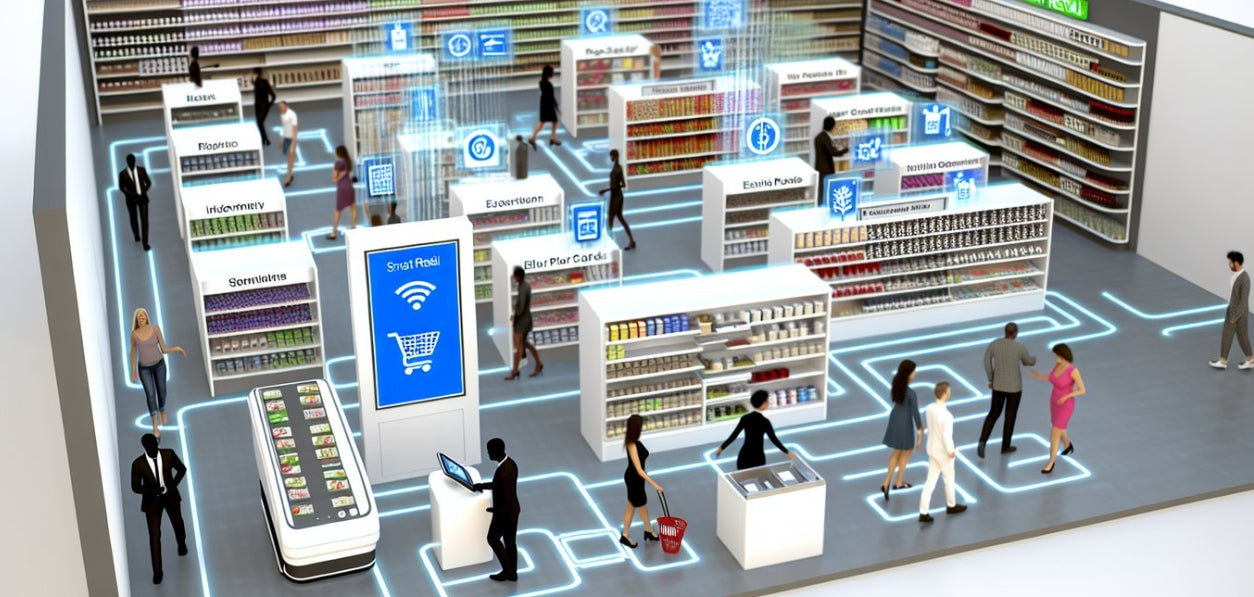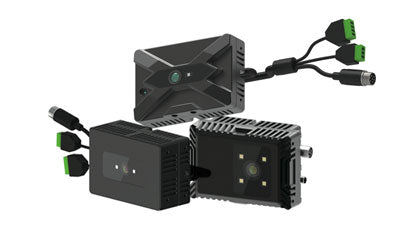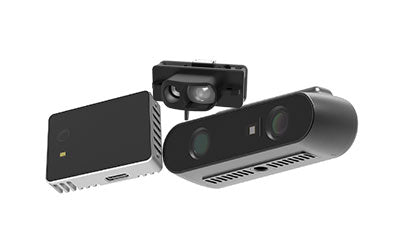From 2D to 3D: TOF Drives the Smart Retail Space Revolution

As smart retail rapidly evolves, businesses are no longer satisfied with traditional 2D cameras or infrared sensors for rough behavioral sensing. Retail environments demand higher-dimensional data, more accurate behavior insights, and safer, more interactive experiences. TOF (Time-of-Flight) 3D sensing technology, with its exceptional depth perception and privacy advantages, is leading smart retail from two-dimensional observation to three-dimensional understanding, opening a new chapter of retail digitalization.
What is ToF (Time-of-Flight) Technology?
ToF (Time-of-Flight) is a technology that measures the time it takes for a laser pulse to travel from the emitter to the object and back to the sensor. By calculating this time, it accurately determines the distance to the object, producing 3D spatial point clouds. Widely used in object detection, environmental sensing, and navigation, ToF enables precise depth imaging and real-time spatial awareness.
Upgraded Demands for Behavior Perception and Scene Interaction in Smart Retail
With the rise of smart retail, the need for precise behavior analysis and real-time spatial interaction has intensified. While 2D cameras can capture basic visuals such as outlines and movement directions, they are often limited by occlusions, lighting changes, and fixed angles—reducing accuracy. Additionally, in privacy-sensitive zones like fitting room entrances or checkout counters, 2D monitoring may trigger customer concerns, impacting the experience.
New applications like unmanned stores, smart shelves, virtual fitting mirrors, and interactive ad displays demand high-precision spatial awareness, fine motion capture, and real-time interaction. TOF cameras excel in these areas by providing:
-
Behavioral Analysis at Virtual Mirrors: TOF cameras accurately track body posture, standing duration, and subtle movements like trying-on gestures or head nods—helping personalize recommendations.
-
Shelf Interaction Detection: TOF can capture hand trajectories and grabbing actions in real-time, distinguishing between picking up, returning, or browsing—enabling better shelf arrangement and inventory planning.
-
Customer Flow and Route Optimization: Through 3D modeling and movement tracking, TOF enables real-time analysis of foot traffic patterns and density, offering key insights for display layout and promotional strategy optimization.
Thanks to its non-contact distance measurement, strong performance in low-light environments, and privacy-safe design, TOF enhances both operational efficiency and user confidence. As a result, 3D TOF cameras are becoming essential for enabling closed-loop sensing and interaction in retail, pushing the industry toward greater intelligence, efficiency, and personalization.
Empowering Smart Retail: From Customer Movement to Spatial Optimization
TOF technology emits near-infrared pulses and measures their return time, rapidly creating high-resolution depth maps with centimeter-level accuracy. With advantages such as real-time responsiveness, strong anti-interference, and low-light adaptability, TOF is widely applied in smart retail to enhance both the consumer journey and store management.
1. Customer Path Tracking and Behavior Recognition
With TOF cameras, retailers can track customer movement paths, dwell locations, and time spent in specific areas. AI-powered behavior recognition identifies patterns like browsing, queuing, turning, or exiting. These insights help reveal customer interest in different zones, highlight cold/hot areas, and support data-driven decisions on product placement, shelf layout, and promotional planning.
2. Shelf Interaction Analytics
Unlike traditional vision systems, TOF enables accurate detection of hand movements, such as picking up or putting back items. Integrated with weight sensors or RFID, TOF-equipped shelves offer real-time stock updates and restocking alerts, improving inventory accuracy and automation.
3. 3D Foot Traffic and Heatmap Analysis
2D systems often fail in crowded or obstructed spaces. TOF builds complete 3D heatmaps, detecting variations in height and density—even identifying children or seated customers. TOF also tracks people count trends by time and area, offering valuable insights for tenant attraction, rent pricing, and event planning.
4. Smart Fitting Mirrors and Virtual Experience
For immersive retail, TOF combined with RGB sensors creates an RGB-D system capable of high-precision body modeling and skeleton tracking. It captures details like gestures and posture changes to enhance virtual try-on realism. This enables personalized styling, contactless shopping, and digital merchandising innovations.
By enhancing perception and interaction capabilities, TOF is unlocking new efficiencies and experiences in retail. It bridges the gap between customer behavior and spatial intelligence, helping retailers achieve visualized operations, personalized services, and data-driven management—ushering in a smarter and more responsive retail future.
TOF vs Thermal Imaging / Traditional Cameras: A Win-Win for Privacy and Accuracy
Compared to traditional cameras and thermal imaging devices, Time-of-Flight (TOF) technology holds significant advantages in smart retail:
-
Stronger Resistance to Light Interference: TOF sensors are not sensitive to ambient light changes, allowing stable operation even in bright or backlit environments.
-
No Facial Data Collection: TOF captures only depth and motion, eliminating concerns over user privacy breaches and easing regulatory compliance.
-
High Refresh Rate and Low Latency: Real-time data acquisition makes it ideal for dynamic interaction systems, such as unmanned checkout and intelligent recommendations.
These strengths make TOF one of the best solutions for non-intrusive user behavior analysis.
Key TOF Applications in Smart Retail Scenarios
1. Unmanned Convenience Stores
In unmanned convenience stores, TOF depth cameras integrate deeply with AI vision technologies, becoming a cornerstone for contactless payment and intelligent operations. With precise 3D spatial perception, the system can accurately track customer entry/exit paths, dwell locations, and behavioral movements—enabling full-process tracking of each customer’s 'pick up–put back–checkout' actions.
TOF's depth data effectively eliminates blind spots caused by occlusion or lighting changes in traditional 2D cameras, enhancing object recognition accuracy and transaction security. Combined with AI algorithms, the system can also detect suspicious behaviors (e.g., taking goods without paying), ensuring store safety and supporting a smooth, cashier-free shopping experience.
2. Smart Fitting Mirrors
Smart fitting mirrors equipped with RGBD cameras and TOF sensors accurately capture users’ 3D body shapes and postures, enabling realistic virtual try-on experiences. TOF cameras not only measure body dimensions but also perceive limb movements and angles in real time, ensuring that virtual garments deform and fit naturally with user motion. Based on this data, the system can recommend clothing sizes and styles tailored to the user’s physique and preferences, even drawing on past try-on history to offer personalized suggestions. Most importantly, TOF technology maintains performance across different lighting conditions, ensuring a seamless and immersive fitting experience and advancing digital fitting room technology to the next level.
3. Intelligent Shelf Systems
Leveraging TOF depth-sensing technology, intelligent shelves can monitor customer behaviors in front of them in real time. By analyzing hand movements—such as picking up and putting down products—the system accurately detects inventory changes and distinguishes between purchases and mere trials, improving inventory management precision. TOF’s 3D sensing capability maintains high sensitivity even in complex conditions like occlusions or stacked products, significantly reducing missed detections and errors. Additionally, by analyzing customer dwell time and visit frequency, retailers can gain insights into product popularity and attention, enabling smarter restocking reminders and promotional strategies to maintain a dynamic balance between stock and sales.
4. Space Layout and Traffic Flow Optimization
TOF cameras play a vital role in optimizing space layout and customer flow, especially when paired with smart robots (such as SLAM navigation robots). TOF provides high-precision 3D data for real-time mapping of store interiors. Using SLAM (Simultaneous Localization and Mapping) algorithms, robots can build detailed 3D maps, detect obstacles and dynamic crowds, and autonomously plan optimal patrol or guide paths.
By continuously capturing customer movement and dwell behavior, the system helps store operators analyze bottlenecks and traffic patterns, enabling scientific adjustments to shelf arrangements and promotional zones—enhancing shopping comfort and operational efficiency. In the future, TOF-powered SLAM robots will become versatile tools in smart retail for inspection, product navigation, and customer service, pushing digital transformation to new heights.
TOF technology, across these core retail scenarios, significantly enhances sensing accuracy and real-time capability. It underpins unmanned operations, immersive experiences, and intelligent management—driving the industry into a new era of smart, digital, and personalized retail.
The Synergistic Evolution of TOF and Retail Space Digitization
Future retail spaces will no longer be static display areas but intelligent interactive systems that can 'sense,' 'learn,' and 'respond.' TOF 3D cameras, RGB-D cameras, 3D SLAM, and visual navigation technologies will converge into unified retail AI platforms, forming a complete loop from data acquisition and analysis to behavioral feedback.
For instance, a 3D robotics company might integrate 3D TOF cameras + AI analytics systems + AGV material handling equipment to create a comprehensive smart warehousing and retail sorting system—improving supply chain efficiency while minimizing human intervention.
At the same time, with 2024 semiconductor trends driving down TOF sensor costs and enhancing precision, the adoption rate of TOF technology in the retail sector is set to accelerate further.
Conclusion: TOF Reshapes the 'People-Goods-Place' Dynamic, Ushering in a New Era of Smart Retail
From 2D imaging to 3D depth sensing, from passive monitoring to active interaction—TOF technology is revolutionizing how the retail industry captures data and engages with customers. With ongoing advances in 3D sensing, RGB-D imaging, and SLAM-based vision, retailers will gain unprecedented insight into consumer behavior, optimize space utilization, and elevate user experiences.
In the path toward intelligent integration of 'people, goods, and spaces,' the TOF 3D depth camera is emerging as an essential engine—powering smart retail toward a higher-dimensional future.
Synexens Industrial Outdoor 4m TOF Sensor Depth 3D Camera Rangefinder_CS40p
After-sales Support:
Our professional technical team specializing in 3D camera ranging is ready to assist you at any time. Whether you encounter any issues with your TOF camera after purchase or need clarification on TOF technology, feel free to contact us anytime. We are committed to providing high-quality technical after-sales service and user experience, ensuring your peace of mind in both shopping and using our products.





